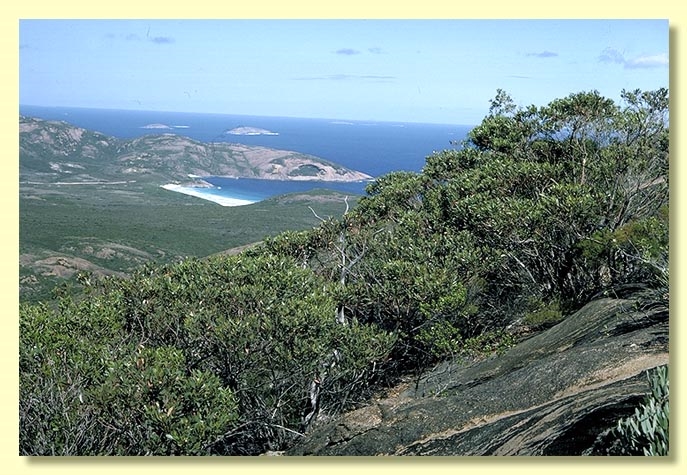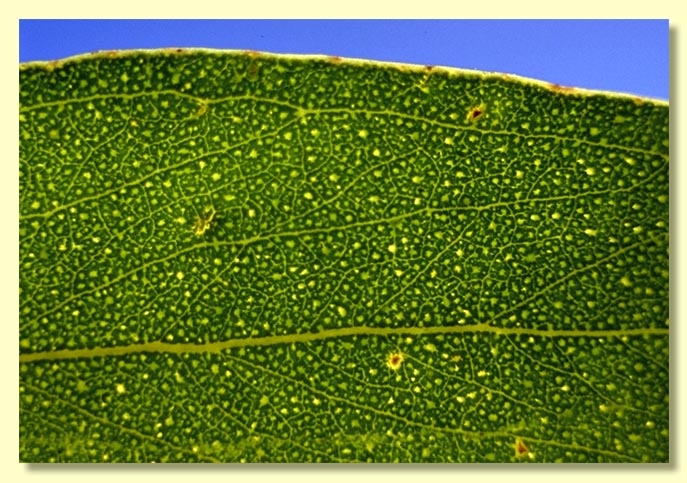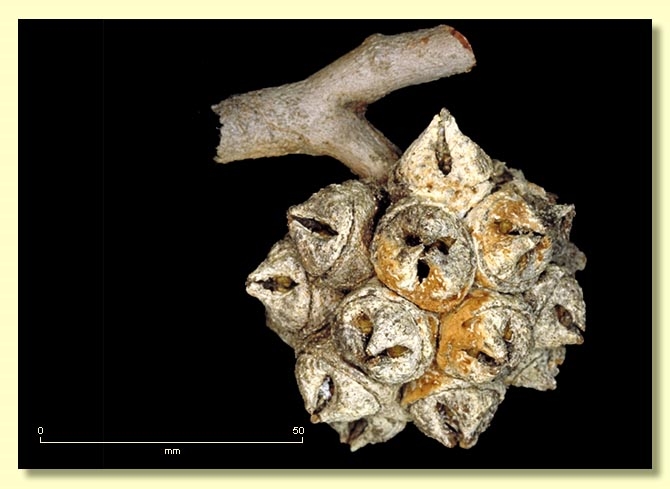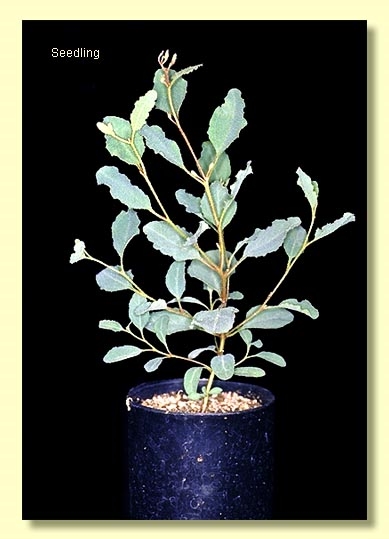Euclid - Online edition
Eucalyptus conferruminata subsp. conferruminata
Eucalyptus | Symphyomyrtus | Bisectae | Hadrotes | Lehmannianae | Conjunctae
T: Middle Mt Barren, W.A., 16 July 1970, A.S.George 10097; holo: PERTH.
Bushy-crowned tree to 5 m tall or shrub (marlock), with single stem branching low. Lignotuber absent.
Bark smooth throughout, whitish and grey to light grey-tan, shedding in strips.
Branchlets lack oil glands in the pith.
Juvenile growth (coppice or field seedlings to 50 cm): not seen
Adult leaves held more or less erect, alternate, petioles 0.2–0.6 cm long; blade elliptical to oblanceolate, 4.6–9.3 cm long, 1.3–3.2 cm wide, base tapering to petiole, margin entire or distantly notched (lenticels sometimes present), apex rounded and mucronate or broadly pointed, concolorous, mid-green, slightly glossy, side-veins acute, reticulation moderate and broken, intramarginal vein remote from margin and sometimes with a second vein close to margin, oil glands scattered, intersectional.
Inflorescence axillary unbranched, peduncles coarse, broad and strap-like, 2.2–5.7 cm long, 1.4–2.8 cm wide apically, buds 7–19 per umbel, pedicels absent. Buds syncarpous (all of the buds in an umbel are completely joined by the hypanthium only, the upper part of each bud remaining free); scar left by early shedding of outer (sepaline) operculum is present but may become obscure late in bud development, at maturity the stoutly horn-shaped inner operculum is 3.5–4.5 cm long, whilst its width measured at the base is 1–2.1 cm; stamens erect, long, anthers narrowly oblong, versatile, dorsifixed, dehiscing by longitudinal slits, style long and straight, stigma blunt, locules 3, the placentae each with (?6)–8 vertical rows of ovules; flowers green to yellow-green.
Fruit on stout down turned-peduncles, syncarpous, the complete woody mass up to ca 6.5 cm diameter, individual capsules in the woody mass (1.4)2–2.5 cm wide, length not measurable, dehiscing by elliptical holes formed as the 3 valves split along the sutures but remain connected apically, disc covers the entire surface of the valves.
Seeds blackish brown, 1.5–3.5 mm long, angularly ovoid to cuboid, dorsal surface shallowly reticulate, hilum ventral to terminal.
Cultivated seedlings (measured at ca node 10): cotyledons coarsely Y-shaped; stems triquetrous when young but becoming rounded in cross-section, densely scabrid; leaves always petiolate, opposite for ca 5 nodes then alternate, broadly ovate or deltoid, 4.5–7.5 cm long, 3–6 cm wide, base truncate to rounded or tapering, apex usually rounded, margin wrinkled and indented, green, discolorous, scabrid; scabridity is due to bristle-glands with stellate apices which are most prominent on stems, petioles, leaf margins and veins on underside of lamina but only sparse on lamina generally.
Flowering has been recorded in October.
There are two subspecies:
E. conferruminata subsp. conferruminata
The western subspecies has been recorded from Flinders Peninsula south of Albany, and between Middle Mount Barren and the Whoogarup Range in Fitzgerald River National Park, usually on very exposed harsh coastal sites. It is distinguished by having mature opercula 1-2.1 cm wide at the base (operculum ratio length:width falls in the range 1.7-2.2).
E. conferruminata subsp. recherche
This is the eastern subspecies having been recorded from the following islands of the Recherche Archipelago: Woody, North Twin Peak, Sandy Hook, Middle and Mondrain. It has also been found on the coast adjacent to the archipelago at Mount LeGrand, and by Robert Brown in 1802 at what is now called Lucky Bay. It has mature buds with opercula 0.8-1.1 cm wide at the base (operculum ratio length:width falls in the range 2.8-4).
In the classification of Brooker (2000) Eucalyptus conferruminata belongs in Eucalyptus subgenus Symphyomyrtus section Bisectae subsection Hadrotes because the cotyledons are coarsely Y-shaped, buds have an operculum scar, a long (inner) operculum and erect stamens, fruit which are large, thick-rimmed and held rigidly on the peduncles. Of the twelve species in subsection Hadrotes ten lack oil glands in the pith of the branchlets and have scabrid seedlings. Together these ten species form series Lehmannianae, a group further characterised by having fruit with exserted valves that remain fused at their tips after seed shed, a feature shared with the more distantly related E. cornuta.
Of the ten species in series Lehmannianae six, E. conferruminata, E. lehmannii, E. mcquoidii, E. arborella, E. sinuosa and E. retusa have the buds (and fruit) in each axillary cluster fused basally (forming subseries Conjunctae), whilst the other four species, E. newbeyi, E. burdettiana, E. talyuberlup, and E. megacornuta, have buds and fruit free (forming subseries Liberae).
E. conferruminata is distinguished from its five near relatives by its stoutly horn-shaped opercula always <4 times as long as wide. E. lehmannii, E. mcquoidii, E. sinuosa and E. arborella all have much longer and more slender opercula, >4 time as long as wide. E. lehmannii and E. sinuosa are further distinguished by being mallees. The mallet E. mcquoidii differs further by having terete, not flattened, peduncles and up to ca 50 buds per cluster (cf. up to 27 buds for the other five species). E. retusa has smaller buds and fruit only partially fused in the cluster, and has terete peduncles.














